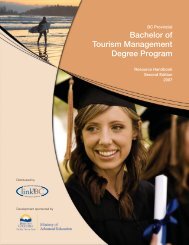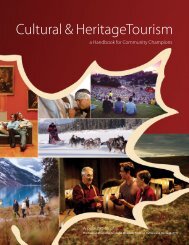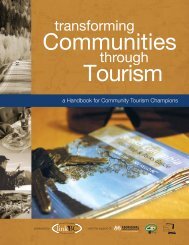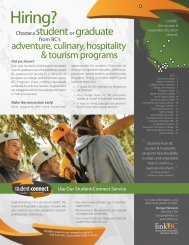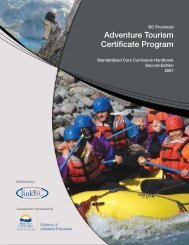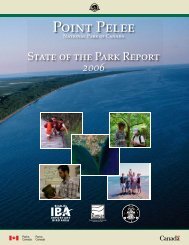Biologically-Respectful Tourism - LinkBC
Biologically-Respectful Tourism - LinkBC
Biologically-Respectful Tourism - LinkBC
You also want an ePaper? Increase the reach of your titles
YUMPU automatically turns print PDFs into web optimized ePapers that Google loves.
instance, has just 139 ha protected, divided between three separated areas. Such fragmentation is deemed inadequate to<br />
maintain biodiversity.<br />
The Sunshine Coast is one of the few remaining regions in British Columbia that does not yet have a strategic land use plan or<br />
regional growth management framework. Between 2001 and 2006 the population rose 8.4%. This accelerated growth, combined<br />
with the proximity to Vancouver has brought the region under development pressure, resulting in escalating land‐use conflicts<br />
between economic sectors.<br />
The campaigns highlighted a sense of insufficient community engagement in the stakeholder and judicial processes. Some<br />
campaigns were underpinned by demand for more accountability from resource professionals and a perceived lack of sustainability<br />
in logging, fishing, and mining practices. A proposed deep sea mining port elicited a strong reaction from the community and was<br />
the catalyst for another campaign. An extreme decline of the salmon fishery was the direct impetus for two additional projects.<br />
Many cited the forestry industry, the laws governing its practices, and impacts including: logging approvals in at‐risk species habitat,<br />
silty water impacting the community watershed, and proposed developments within various sensitive eco‐systems.<br />
The condition of threatened, endangered, unique, and key commercial species and special habitats provided impetus to identify<br />
and create ‘wildlife habitat areas’ or ‘ecological reserves’ or new protected zones. One project heralded the discovery of a new<br />
species pair of small freshwater fish that represented ‘an example of parallel evolution in nature’ that was ‘found nowhere else on<br />
Earth’. The proliferation of invasive plants such as: Purple Loosestrife, Himalayan Blackberry, Scotch Broom, Evergreen Blackberry,<br />
Yellow Flag, and St. John's Wort were seen as threats to native flora and a Biodiversity Strategy Framework was envisioned for the<br />
whole Sunshine Coast.<br />
The combination of these issues resulted in twenty campaigns the researcher clustered into two distinct themes; land and ocean<br />
protection & management (LOPM), and wildlife protection & management (WPM). It is noted that cross‐over did occur between<br />
themes.<br />
LAND & OCEAN PROTECTION AND MANAGEMENT CLUSTER<br />
Table 2 provides a comparative analysis of the ten campaigns/projects undertaken by nine separate organizations clustered under<br />
LOPM. The table shows the aim of the campaign, the primary target for the campaign and the perceived results. The table was<br />
constructed with the help of eight surveys along with four unstructured interviews and attendance at two events.<br />
Page 16



